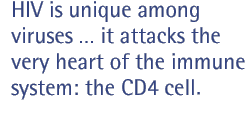Where in the body does HIV infection occur | How does the immune system work? | Who are the team players? | How does HIV attack the immune system?

Where in the body does HIV infection occur?
HIV targets the lymphocyte type of white blood cell. There are three components to the blood: red blood cells, white blood cells and plasma. Although blood appears red when it comes out of the body, if one were to put it in a centrifuge, it would separate out. A wide clear band of plasma would rise to the top and the red blood cells would sink to the bottom. In the middle would be a thin layer of white blood cells.
How does the immune system work?
The human immune system is one of the human body's enduring mysteries; scientists still do not completely understand how it works. It is an incredibly complex network of cells that identifies foreign invaders, kills them, and then remembers them in order to prevent future infections.
The immune system comprises three parts that work together to protect against disease:
- Physical barriers to germs; for example, the skin
- The innate immune system, which is designed to attack and destroy any outside invader that gets into the bloodstream
- The acquired immune system, which has been trained to identify and kill particular invaders, either through previous experience or by a vaccine
Collectively, the cells of the immune system are known as white blood cells. These cells originate from the lymphatic system organs, which include the tonsils, lymph nodes and bone marrow. As far as scientists have determined, each cell plays a specific role in fighting disease.
Who are the team players?
Imagine the immune system as a very big football team, whose members cannot see or talk to each other, but who are organized by a quarterback constantly sending each player a stream of invisible messages to each player. In the human body, the role of the quarterback is filled by the CD4 cell (also known as the "helper T-cell"), which dictates the behavior of the other immune cells almost from the moment of infection. The major types of cells controlled by the CD4 cell are the following:
- Antigen-presenting cells (APCs) are the front line of the immune system. Constantly patrolling, they are responsible for finding foreign cells -- by recognizing bits of proteins, or antigens, on the surface of a virus which mark it as an invader -- gobbling them up, and pasting pieces of the viral antigens on their surfaces. That is a signal to the CD4 cell that the body is under attack, and it needs to mobilize the other players.
- B-cells produce antibody molecules that are specifically designed to tackle and lock onto antigens on the surface of virus particles to prevent it from replicating.
- Macrophages are scavenger cells that find and kill any virus particles marked by the antibodies deposited by B-cells.
- Killer T-cells hunt for viral antigens which indicate a body cell has been infected with a virus, and turned into a virus-producing machine. The killer T-cell, as its name suggests, kills the body cell to stop it from producing more virus particles.
Within a few days, the immune system can kill a typical flu or cold virus. But once a virus is eliminated, the body doesn't forget about it. Some of the B-cells and T-cells that were mobilized for the fight become memory cells which stay in the body for many years. If the same virus comes back, those cells will quickly find it, reproduce themselves and eliminate it, probably before you ever become sick. That's why some diseases, like chicken-pox, only strike once in a lifetime.
How does HIV attack the immune system?
HIV is unique among viruses because it attacks the very heart of the immune system: the CD4 cell. By targeting that cell, the virus interrupts the entire immune response.
